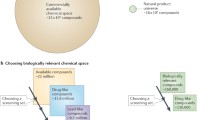Abstract
Antimicrobial research is geared toward the discovery and development of novel chemical structures such as therapeutic antimicrobial agents. The continuing problem of development of resistance to existing antibacterial agents and the dearth of good antifungal agents motivates this effort toward innovation. Selection of possible new enzyme targets for antibiotic inhibition may be made on theoretical grounds, but it appears premature to select any single, previously unvalidated target for the intensive study required for rational drug design. Instead, a broad screen of chemical entities can be undertaken, dedicated to the discovery of novel antimicrobial inhibitors. A number of target areas are under investigation, including fungal mRNA splicing and bacterial DNA synthesis. A major part of the endeavor is in the historically productive area of natural product screening. To make the best use of natural product resources for the discovery of novel antibiotics, a balance is struck between screening for inhibitors of rationally chosen targets for which clinically useful inhibitors are not yet available, and screening more broadly to ensure that rare activities of unanticipated mode-of-action are not missed.
Similar content being viewed by others
References
Parsons WH, Patchett AA, Bull HG, Schoen WR, Taub D, Davidson J, Combs PL, Springer JP, Gadebusch H, Weissberger B: Phosphinic acid inhibitors of D-alanyl-D-alanine ligase. Journal of Medicinal Chemistry 1988, 31: 1772–1778.
Li RL, Poe M: Quantitative structure-activity relationships for the inhibition ofEscherichia coli dihydrofolate reductase by 5-(substituted benzyl)-2,4-diaminopyrimidines. Journal of Medicinal Chemistry 1988, 31: 366–370.
Hammond SM, Claesson A, Jansson AM, Larson LG, Pring BG, Town CM, Ekstrom B: A new class of synthetic antibacterials acting on lipopolysaccharide biosynthesis. Nature 1987, 327: 730–732.
Goldman R, Kohlbrenner W, Lartey P, Pernet A: Antibacterial agents specifically inhibiting lipopolysaccharide synthesis. Nature 1987, 329: 162.
Strominger JL, Willoughby E, Kamiryo T, Blumberg PM, Yocum RR: Penicillin-sensitive enzymes and penicillin-binding components in bacterial cells. Annals of the New York Academy of Science 1974, 235: 210–224.
Pestka S: Inhibitors of protein synthesis. In: Weissbach H, Pestka S (ed): Molecular mechanisms of protein biosynthesis. Academic Press, New York, 1977, p. 467–553.
Reynolds PE: Studies on the mode of action of vancomycin. Biochemical Biophysical Acta 1961, 52: 403–405.
Mitscher LA, Zavoid RM, Sharma PN, Chu DT, Shen LL, Pernet AG: Recent advances on quinolone antimicrobial agents. In: Davis BD, Ichikawa T, Maeda K, Mitscher LA (ed): Horizons on antibiotic research. Japan Antibiotics Research Association, Tokyo, 1988, p. 166–193.
Davis BD: Mechanism of bactericidal action of aminoglycosides. Microbiological Reviews 1987, 51: 341–350.
Beise F, Labischinski H, Giesbrecht P: Role of the penicillin-binding proteins ofStaphylococcus aureus in the induction of bacteriolysis by β-lactam antibiotics. In: Actor P, Daneo-Moore L, Higgins ML, Salton MRJ, Schockman GD (ed): Antibiotic inhibition of bacterial cell surface assembly and function. American Society for Microbiology, Washington, DC, 1988, p. 360–366.
Wehrli W: Rifampin: mechanisms of action and resistance. Reviews of Infectious Diseases 1983, 5, Supplement 3: 407–411.
Klasterky J, Van der Auwera P: Cephalosporins, vancomycin, aminoglycosides and other drugs, especially in combination, for the treatment of methicillin-resistant staphylococcal infections. Journal of Antimicrobial Chemotherapy 1986, 17, Supplement A: 19–24.
Tomasz A: The role of autolysins in cell death. Annals of the New York Academy of Science 1974, 235: 439–447.
Moyed HS, Bertrand KP:hipA, a newly recognized gene ofEscherichia coli K-12 that affects frequency of persistence after inhibition of murein synthesis. Journal of Bacteriology 1983, 155: 768–775.
Smith JT, Lewin CS: Chemistry and mechanisms of action of the quinolone antibacterials. In: Andriole JT (ed): The quinolones. Academic Press, London 1988, p. 23–82.
Scherrer R, Moyed HS: Conditional impairment of cell division and altered lethality inhipA mutants ofEscherichia coli K-12. Journal of Bacteriology 1988, 170: 3321–3326.
Vijayraghavan U, Company M, Abelson J: Isolation and characterization of pre-mRNA splicing mutants ofSaccharomyces cerevisiae. Genes and Development 1989, 3: 1206–1216.
Warner JR: Applying genetics to the splicing problem. Genes and Development 1987, 1: 1–3.
Cheng S-C, Abelson J: Spliceosome assembly in yeast. Genes and Development 1987, 1: 1012–1027.
Clark MW, Goelz S, Abelson J: Electron microscopic identification of the yeast spliceosome. EMBO Journal 1988, 7: 3829–3836.
McMacken R, Silver L, Georgopoulos C: DNA replication. In: Neidhardt FC, Ingraham JL, Low KB, Magasanik B, Schaechter M, Umbarger HE (ed):Escherichia coli andSalmonella typhimurium: cellular and molecular biology. American Society for Microbiology, Washington, DC, 1987, p. 564–612.
Bramhill D, Kornberg A: A model for initiation at origins of DNA replication. Cell 1988, 54: 915–918.
Haslam E: Secondary metabolism — fact and fiction. Natural Products Reports 1986, 3: 217–249.
Demain AL: Functions of secondary metabolites. In: Hershberger CL, Queener SW, Hegeman G (ed): Genetics and microbiology of industrial microorganisms. American Society for Microbiology, Washington, DC, 1989, p. 1–11.
Zähner H. Drautz H, Weber W: Novel approaches to metabolite screening. In: Bu'Lock JD, Nisbet LJ, Winstanley DJ (ed): Bioactive microbial products: search and discovery. Academic Press, New York, 1982, p. 51–70.
Williams DH, Stone MJ, Hauck PR, Rahman SK: Why are secondary metabolites (natural products) biosynthesized? Journal of Natural Products 1989, 52: 1189–1208.
Chater KF: The improving prospects for yield increase by genetic engineering in antibiotic-producing streptomycetes. Bio/Technology 1990, 8: 115–121.
Author information
Authors and Affiliations
Rights and permissions
About this article
Cite this article
Silver, L., Bostian, K. Screening of natural products for antimicrobial agents. Eur. J. Clin. Microbiol. Infect. Dis. 9, 455–461 (1990). https://doi.org/10.1007/BF01964283
Issue Date:
DOI: https://doi.org/10.1007/BF01964283




